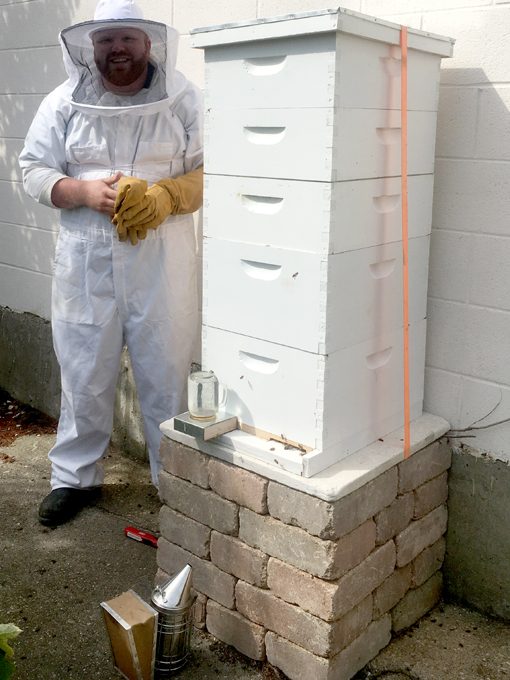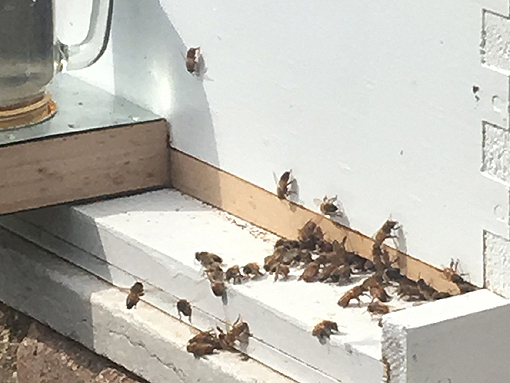
Resident apiarist Nick, defying post-Labor Day attire etiquette, next to our beehive, which began as a single box in May of this year (Apiarist: fancy term for beekeeper).
Summer is coming to a close, which means harvest time for most beekeepers. The bee colony we started in late spring of this year has flourished this summer and we couldn’t be more excited by the progress our bees have made. More importantly, we are amazed with what we have learned from these incredible insects!
We installed our bees on May 7th after transporting them from Dadant and Sons, in Watertown, WI. (https://www.dadant.com/) Throughout the summer, we’ve watched the tiny pollinators endlessly explore our nursery, gather pollen and return to the hive. We had a mid-season check-up from local bee-enthusiast Jana Kinsman (http://www.bikeabee.com/). Jana was very encouraging and said our hive was on the right path to success. During her visit, we located freshly laid eggs, a sign of a healthy queen, larvae in different stages of growth and many pollen stores and honey-filled cells. Aside from daily visual inspections and opening the hive about once every two weeks, this experience was relatively easy and a lot of fun!
Challenges
However, as expected, or bees faced some challenges in early August, in the form of Yellowjackets. Yellowjackets are carnivorous wasps that prey on Honey Bees. It is recommended that an entrance reducer be installed on the opening of the hive to suppress the amount of traffic coming and going to the hive, which essentially allows for easier guarding of the entrance.

The entrance reducer (a long piece of wood with small cutout opening) protects the beehive from Yellowjacket attack.
Honey bees are often mistaken for Yellowjackets, which is a main reason Honey bees are so misunderstood. Below is a guide for identifying Honey Bees and Yellow Jackets. Yellowjackets are bright yellow and have a sleek body, whereas Honey Bees actually appear orange. The main difference is Honey Bees are herbaceous and non-aggressive (unless agitated) and Yellowjackets are carnivorous and aggressive. We didn’t install our entrance reducer early enough and the Yellowjackets killed hundreds of our bees. Since installation, it seems as though the hive has bounced back. Yellowjackets are only one of several threats to a hive. Picking up a beginner bee-keeping book or taking a class with the Chicago Honey Coop (http://www.chicagohoneycoop.com/) are both great ways to learn more about beekeeping.
As fall and winter approach, it is important to make sure our bees have enough honey to make it through the winter. Our bees have filled up an entire box, or super, of honey. This year we won’t be harvesting any of liquid gold as one super is the minimum amount a colony will use during the winter.
In preparation for winter, we will start supplemental feeding so the bees aren’t only eating honey once frost sets in. We will condense our hive and get rid of empty boxes. Efficiency is important during the winter so bees shouldn’t have to travel far for food. We are also adding a wind block to our hive in the form of hay bales, to help shield some of the cold winter winds.
Thinking of Starting A Beehive?
Now is the perfect time of year to start planning a beehive. First, make sure beehives are allowed within local municipality limits. Ordinances differ between different communities and it would be a shame to find out bees are not allowed, when your package of 10,000 is due for delivery in April! During fall clean-ups, identify an area with southern exposure, away from children and other loud distractions. Create a blank canvas by clearing weeds and yard debris. We built a pillar for our beehive using dimensional stone; cinder blocks, or even wood pallet can also work well for the base for a hive. Make sure the ground is level, or slightly pitched so rainwater does not collect in the back of the hive. Winter is the perfect time to take a class to learn about beekeeping and get excited about the upcoming spring and a new hobby.


